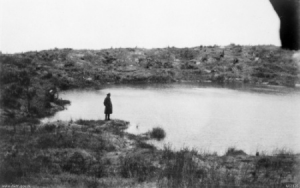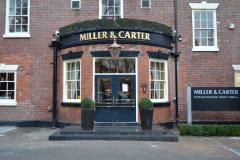
Whilst Haig was planning a major breakthrough North and East out of the Ypres Salient starting on 31 July, General Herbert Plumer's 2nd army achieved an exceptional, but geographically limited, success in June. This was on the Messines Ridge South East of Ypres.
The prudent "Daddy" Plumer had learnt much from the Somme and advocated carefully rehearsed, comprehensive planning in addition to massive artillery bombardment. His step by step "bite and hold" tactics along fronts of about 1,000 yards worked as brilliantly here as at Vimy in April. The British Expeditionary Force was now approaching maximum strength and was perfecting the art of modern warfare albeit on a localized scale.
The Allies had at long last through superior explosives, equipment and listening devices gained superiority in tunnelling. During 1917 19 tunnels, often excavated by ex coal miners, stretched for as much as 2,000 feet, 50 - 120 feet beneath the German lines on the 250 feet high Wytschaete-Messines Ridges. Following a 2 week long barrage of 3.5 million shells, mines were simultaneously detonated at 7am on 7 June.
The explosion was heard miles away in London and 7,000 Germans disappeared off the face of the earth. The whole ridge was taken and the careful Plumer resisted all counter-attacks. Sadly it was not possible to press home the attack over such devastated ground and the struggle ended on 15 June.
Our community lost 6 men at Messines. The first, Captain Frederick Arthur Jervis Eastwood, aged 22, was killed in action on the 6th, serving with D battery 103rd Brigade of the Royal Field Artillery. He was the son of Thomas (a barrister based in Manchester) and Annie of "Highfield" in Styal.
He attended Sedbergh School in Cumbria and later read Engineering at the University of Manchester. He was an accomplished cricketer. Buried at Ferme Olivier cemetery, he is remembered on the family grave at Dean Row Unitarian Chapel, the nearby memorial and at Styal.
The second to perish was also a product of the public school system - 2nd Lieutenant Frederick William Knott who died the day after Eastwood. The public schools lost over 20% of those who enlisted. Trained in the schools' OTC they were often junior officers, much taller than the Tommies. They led their men over the top with revolver in hand - clear targets for the enemy.
Frederick was the second son of Herbert (a master cotton spinner) and Ada of "Sunny Bank", Wilmslow. Educated by a governess and then at Leighton Park near Reading (a Quaker school), he joined the OTC of the Inns of Court as a Solicitor's Clerk in October 1915. Serving with the 9th battalion Yorkshire Regiment, he was killed aged 25 attacking Battle Wood. He has no known grave, but is commemorated at the Menin Gate, Wilmslow URC, St Bart's and the town memorial.
Menin Gate also holds the name of Private Arthur Matthews, who died on the 9th with the 8th battalion Loyal North Lancs (34539) formerly of the Cheshires (54986). He was the son of Annie and the late John of "Rectory View", Wilmslow and the husband of Mary of Mill Brow. He had a daughter Nancy and he had worked as a farm labourer before enlisting. Locally he is remembered in St Bart's and the town memorial.
Also on "Rectory View" was the family home of Private Sidney Williams of the 8th battalion South Lancs (31415) who was killed on the 13th. Born in 1896 he was the son of Daniel and Anne who previously ran the centrally located Harefield Farm, Harefield Drive in the town. The Parish Church and town memorial, as well as the Menin Gate mark his passing.
Private James William Ashpital, 13th battalion Cheshires (50037) died aged 19 on the 15th, and is remembered in Styal and in the Methodist Church there as well as the Menin Gate. His parents, John and Isabelle lived in Ellesmere Avenue, Marple.
Also on the 15th our final fatality of the battle was Private William Henry Priestner, aged 23, of the Manchester Regiment's 16th battalion (10260). A Handforth man, he is remembered in the village and the church as well as on the Menin Gate. He lived with his parents, Henry and Margaret, in "Greyhound Cottage" near Safer Road.
Later on Flanders was to see the death of Private William Henry Mottram of the Royal Scots (2714). Serving with the Machine Guns Corps (82002), he was killed aged 25 on the 25th. He had lived on Morley Road, Wilmslow and had worked with his father William in the local slating business before marrying Sarah of Beckenham in Kent.
The Parish Church, family grave and civic memorial mark his passing as they do Private Herbert Garner who fell in France near Arras on the 5th. He served with the 12th Prince of Wales Own West Yorkshires (47249). He was one of 6 children born to Henry and Mary of Manchester Road. He was a letterpress printer before he joined the Great War and had been living on Altrincham Road.
To relieve the French, to gain access to the rest of the ridge surrounding Ypres and perhaps reach Zeebrugge (home of the deadly U boat fleet) Haig now began planning in earnest the controversial 3rd battle of Ypres. The latter stages of this were called Passchendale, "a more sacred place for the British race does not exist" according to Churchill.
Guest post by Jon Armstrong and Alan Cooper, Wilmslow Historical Society








